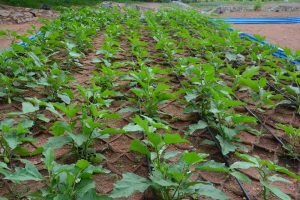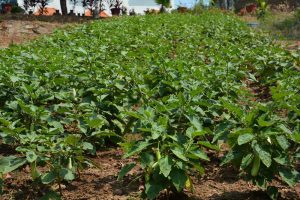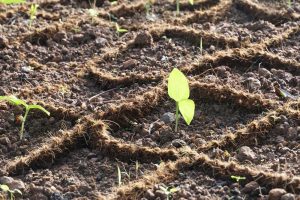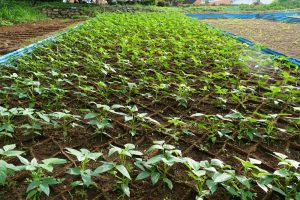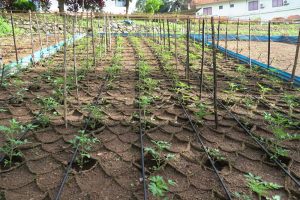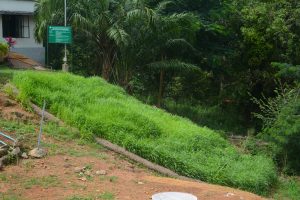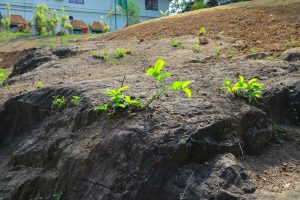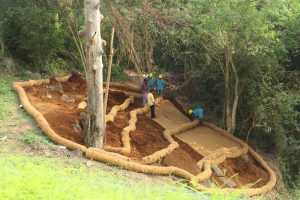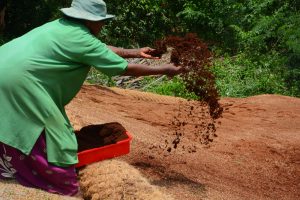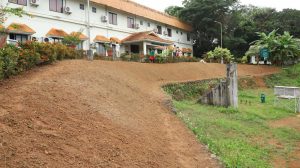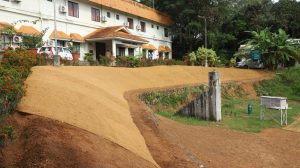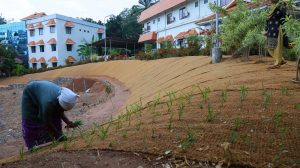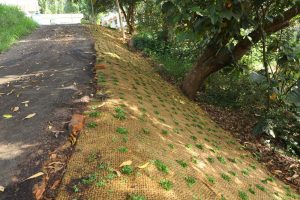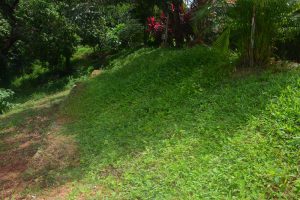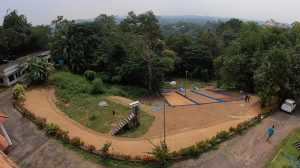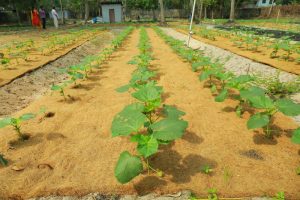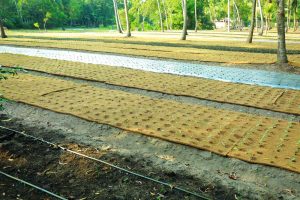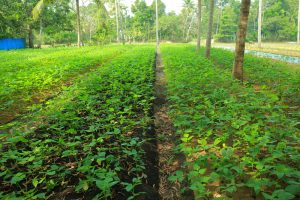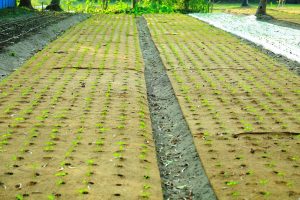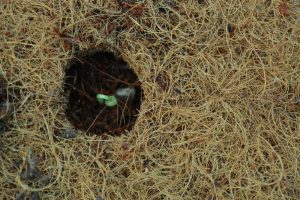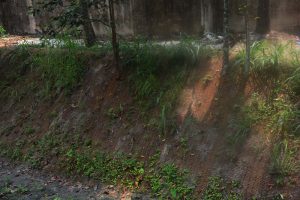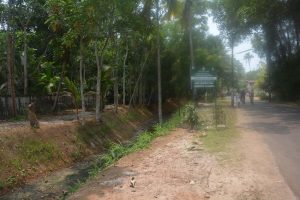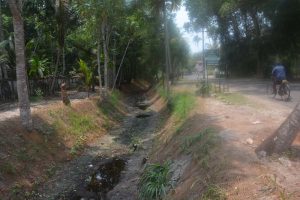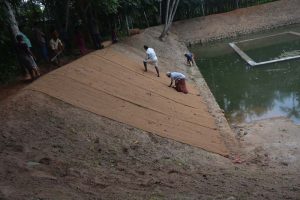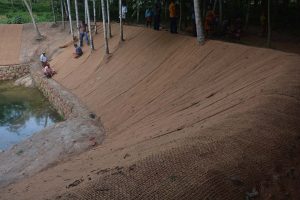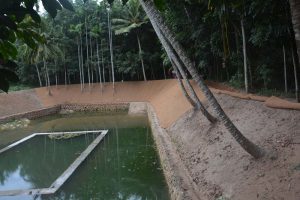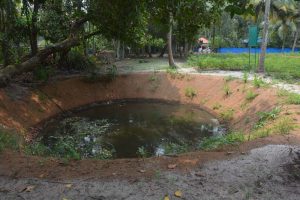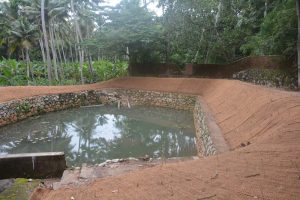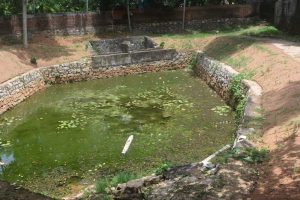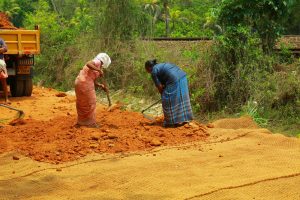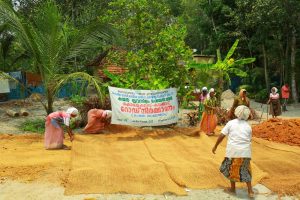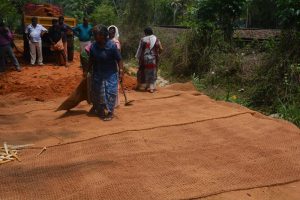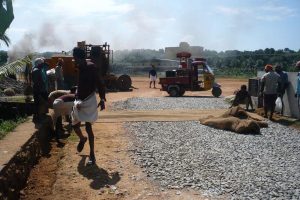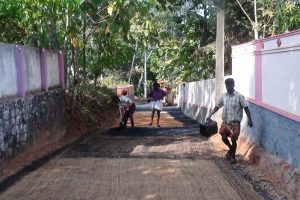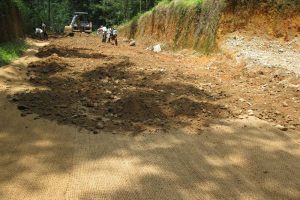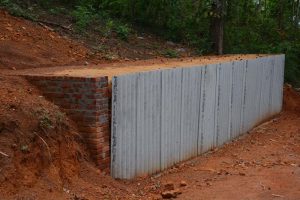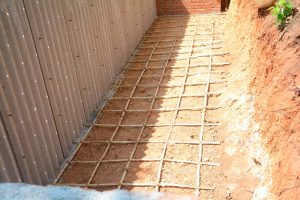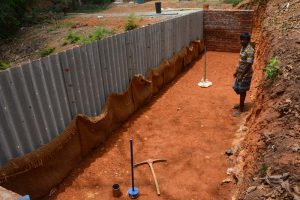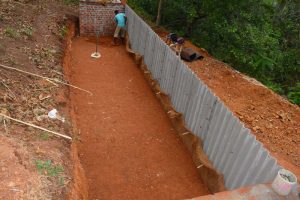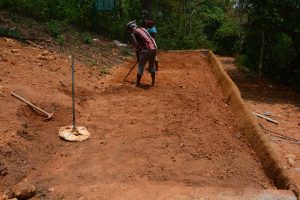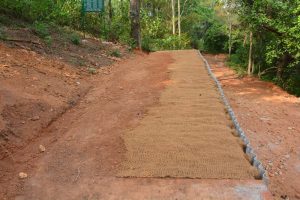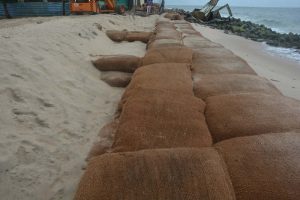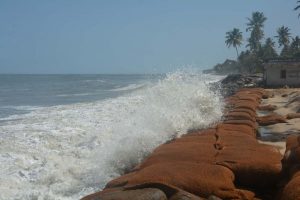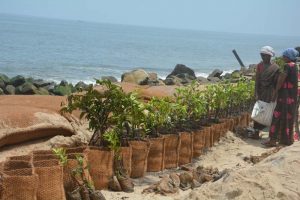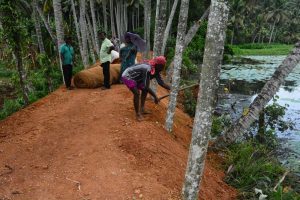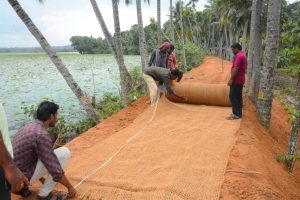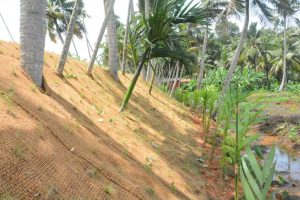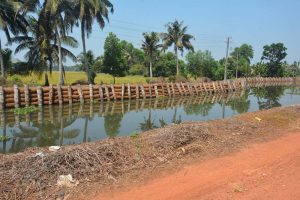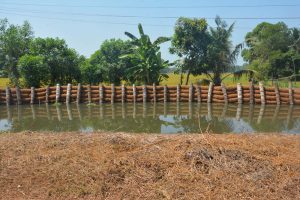About the Division
The research and development division of NCRMI caters the need of coir Industry in Kerala. The division takes up research in the key areas of operation basic research, applied research and development research. This involves new product development, product diversification, technology development, innovative and environmental friendly engineering applications of coir geotextile, demonstrative projects to exhibit the applications of coir geotextile and collaborative projects.
Creative coir – Acoustic panel system in coir
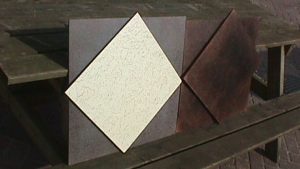
Acoustic panel using different types of coir products of first generation were developed. It can be also used for interior decoration. The acoustic paneling system will serve the purpose of enhancing acoustics and will be cost effective. Preliminary prototypes of coir panels were made with available forms of coir in the market and experimented using different thickness. The same were designed in sizes and shapes to suit different instances where it could be used like false ceilings, partitions, walls etc. An eco-friendly, fire retardant, cost-effective and aesthetically good product was developed. The feature specifications of accoir are as follows:- the product has retrofit features, international standard for the panels, safe and organic, low cost alternative, a low NRC product, durable.
Development of Coir Binderless board
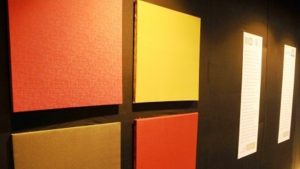
Coconut husk can be used as the base material for the production of environment friendly, binderless, high performance board materials. The specific chemical composition of the coir fibre, in particular its high content of lignin, can be used for the production of high quality coir fibre boards. The husk comprises 30 wt.% coir fibres and 70 wt.% pith. Both fibre and pith are extremely high (over 33%) in lignin and phenolic content. The thermal behaviour of coconut lignin at temperatures above 140 °C, where it melts and shows thermosetting properties, was explored for application as intrinsic binder in board production, utilizing whole fresh husks. A simple and efficient technology has been developed to produce high strength - high density board materials. After separation from the coconut, the husk is refined to small particles and short fibres using a simple opening technique by dry milling, yielding suitable material for conversion into boards by hot pressing. After drying to moisture contents below 12% the milled husk material is evenly spread in the mould/press plate and compressed at high pressure and temperature. The produced board material has been shown to exhibit excellent properties, comparable with or even superior to commercial wood based panels. After pressing the board is cooled in a carrousel and sawn. The boards can be stored on a flat surface on top of each other. The coconut husk boards can be handled with common wood working equipment for drilling, sawing and polishing.
Development of biodegradable mulching mat using coir polymer systems
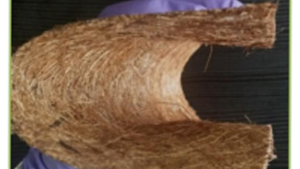
In order to extend the service life of coir mulching mats the use of various polymers as an alternative bonding material was explored as a Collaborative project between NIIST and NCRMI. A range of systems composed of biodegradable coir and polymers as mulching sheets/mats with improved properties was developed. Three systems of bio-based binders; CNSL based, Cardanol based and Castor oil based were studied. The coir mulch mats on laboratory scale were fabricated; both mechanical and optical characteristics were studied. Mulching mats produced from biodegradable materials like coir has several distinct advantages over conventional polymeric mulches.
Product Design and Development of Coir Fiber Reinforced Polymer Composites for Automotive and Domestic Applications
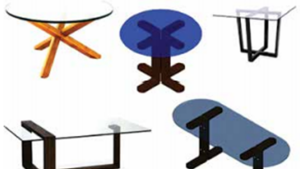
The machine is designEco-friendly sustainable coir fiber reinforced green composites for commercial applications were developed as part of collaborative project between CBPST and NCRMI. The application target was driven by the current needs in the automotive industry to make eco-friendly interior automotive parts. A prototype design was developed for making PP-coir composite domestic products. The products developed were hanger and grow bag stand and the design was accomplished using the Unigraphics software.
The development of eco-friendly material as wood alternative for furniture applications was explored, which utilizes bio or petro based polymers as matrix and agro-waste natural fibres mainly coir fibre as major reinforcing agent. The coir based polymer composite, the new engineering application to the end uses of coir is a best wood substitute.
ed to weave various GSM sizes of Geo-Textile Matting and the major operations of this loom is carried out by pneumatic cylinders. It has production capacity of 100 M (Geo Textile Mat 900GSM) per 8 hrs.
Development of coir geocell system and its application
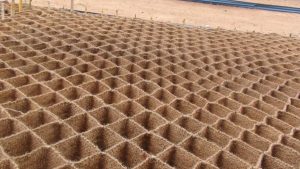
Agri Coir Cells were developed for slope land stabilization and cultivation on steep slopes devoid of top soil. Top soil was filled in the agri coir cell and brinjal (Haritha var.) seedlings were planted after application of the basal dose of manure & fertilizers according to package of practice. Thus cultivation can be done in slope land with the help of agri coir cell. Once placed and secured on slope, the geocell can be filled with soil or a mineral fill. On steep barren slopes where it is difficult to place top soil, agri coir cell of higher GSM with tightly woven coir geo-textile bound in a honeycomb cell like structure is a good alternative. They are laid and fixed on steep slopes using bamboo. The honey comb shaped structure can be filled with soil and saplings planted in them.
Coir geocell – A sustainable product for slope land stabilisation and cultivation
Precipitation and topography are two major prima facia reasons of soil erosion. Regions with sloping topography coupled with high precipitation are susceptible to intense erosion leading to calamities as landslides. A pertinent solution for such occurrence is by vegetative establishment, wherein the soil particles bounded together by the anchorage of rooting system averting the erodibility of soil particles. To revamp such region into cultivable areas and stabilize slope, geocell systems were developed. Geocell are 3 dimensional honey comb structure made of coir geotextile which could contain soil within the cellular structure. Within the cellular confinement, crops could be cultivated which not only reduce the soil loss but also adds to return. Comparative evaluation of soil loss over a slopping land from the treatments of coir geocell, coir geotextile and control is intended through the study. In addition to soil loss analysis, the growth and yield of crops are also assessed. Trials using different crops as brinjal, cowpea, tomato are being assessed.
Erosion control using coir geotextiles by rejuvenation of exposed rock patches
Diversified application of coir in controlling erosion through vegetative rejuvenation. The most befitting solution for abating erosion is through vegetative establishment. This establishment is possible in a media like soil where the rooting is able to be established. But in cases of rocks, the extend of establishment is only meagre. To combat such an issue, combination of coir product paves a way. Coir pith, being sufficient media for growth of vegetation used in coalescence with coir geotextile and cocolog, is intended to be a suitable solution. The exposed rock patches are vegetated by hydro seeding of congo signal grass seeds in media of coir pith spread over the rock patches, secured in place by coir geotextile and cocologs affixed firmly.
Erosion control using coir geotextiles by rejuvenation of exposed rock patches
Diversified application of coir in controlling erosion through vegetative rejuvenation. The most befitting solution for abating erosion is through vegetative establishment. This establishment is possible in a media like soil where the rooting is able to be established. But in cases of rocks, the extend of establishment is only meagre. To combat such an issue, combination of coir product paves a way. Coir pith, being sufficient media for growth of vegetation used in coalescence with coir geotextile and cocolog, is intended to be a suitable solution. The exposed rock patches are vegetated by hydro seeding of congo signal grass seeds in media of coir pith spread over the rock patches, secured in place by coir geotextile and cocologs affixed firmly.
Product Design and Development of Coir Fiber Reinforced Polymer Composites for Automotive and Domestic Applications
The collaborative project between NCRMI, CBPST and CUSAT aims to develop eco-friendly sustainable coir fiber reinforced green composites for commercial applications. The application target was driven by the current needs in the automotive industry to make ecofriendly interior automotive parts such as board panel for door, different boxes, cabin lining, chair parts etc. & domestic products such as disposable spoon, fork, tray etc.
Coir fiber reinforced thermoplastic composites have remarkable interest in an array of applications among the potential natural fibers like kenaf, coir, flax, jute and hemp. Bit coir fibre is abundantly available as waste which can be turned to value added products. Polypropylene is a polymer which finds applications in domestic sector as well as engineering sector. Polypropylene(PP) is reinforced with alkali treated bit coir fibre using extrusion compounding. The present study reports the development of the products hanger and grow bag stand out from PP /coir composite material with a maximum coir content of 30% by means of injection moulding technique. Studies also include the real-life performance of the products in comparison with the available thermoplastic products in terms of load bearing capacity, water absorption and hardness. The products have shown excellent mechanical properties along with low water absorption value andsuperior hardness compared to that of other thermoplastic products.
Development of biodegradable mulching mat using coir polymer systems
The collaborative project between NIIST and NCRMI aims to develop a range of systems composed of biodegradable coir and polymer sasmulching sheets/mats with improved properties and to explore the use of various polymers as an alternative bonding material and to extend service life of coir mulching mats.
Mulches open up new horizons to biodegradable market which is generally applied to the surface ofsoil to preserve soil moisture, improving fertility and health of the soil, reducingweedgrowth and enhancing the visual appeal of the area. Mostly, a mulch is organic in nature either permanent (e.g. plastic sheeting or mats) or temporary (e.g. bark chips or bricks). Plastic mulches or sheets, made of polypropylene or polyethylene provide many positive advantages for the farmer, such as increased durability, enhanced insect management, and weed control. However, removal and disposal of these plastic mulch is a serious environmental concern. Additionally, since it is not porous, plant roots may suffocate and rot.
Production of coir composite for furniture applications
The collaborative project between NIIST and NCRMI aims at thedevelopmentofpolycoirtechnologytolargescaleapplicationswhere thefinetuning ofthe process is envisaged. To carry out,matrix selection and process modification studies to reduce the cost with improvement in performance. To study applications of polycoir in ready-made furniture parts within creased aesthetic values.
Wood has been a standard building and furniture material for centuries. However, with the rise of global warming, increasing emission of greenhouse gases due to deforestation; wood alternatives are increasing in popularity and use, for the sustainable material development. It has been able to create wood substitutes made of composites using synthetic fibres that will decrease the need of wood materials. But, synthetic fibres used for reinforcing composites such as glass fibre, carbon fibres and aramid fibres are expensive, difficult in processing and handling, higher density, higher process energy requirements, difficult to recycle, higher emission of toxic fumes during incineration at the end of life and also non-bio degradable. The development of eco-friendly material as wood alternative for furniture applications was explored, which utilizes bio or petro based polymers as matrix and agro-waste natural fibres mainly coir fibre as major reinforcing agent.
Large scale production of coir composite for acoustic application
The collaborative project between NIIST and NCRMI aims to develop the process for the production of polymer/ coir composites with tailor-made acoustic characteristics with respect to matrix and design aspects. To carry out, matrix selection and process modification studies to reduce the cost with improved performance, to carry out the demonstration, production and field trials of theacoustic panelling materials. The acoustic materials used in automotive and building interiors for noise cancellation are basically of glass wool, polyurethane and gypsum. The demand for ecofriendly, cost effective and light weight composites with better sound absorption coefficients is quite high.
Use of coir fibre as reinforcing material in cement mortar
This is a collaborative project between NCRMI and CUSAT. The materials used for the study are ordinary Portland cement 43 grade conforming to IS:8112-2013 as control binder and treated coir fibres pertaining to different lengths. The fibres were varied in different percentages based on previous research works in this field. The coir fibres were treated in 5% NaOH solution for 72 hours then washed, dried and cut into required lengths. The purpose of treatment is to ensure proper bondage of fibres with the matrix. sodium hydroxide were used for the treatment of coir fibres. All the materials were tested for their basic parameters as per relevant codes.Natural fibres have got an immense potential in inhibiting crack propagation and enhancing mechanical properties of binders. Among the natural fibres, coir fibres absorbs less water, imparts greater compressive strength and impact resistance. This is mainly due to its greater lignin content compared to cellulose rich fibres.Compressive strength of the reinforced binder was found to attain early strength.
Development of polymer coir composites for electrical insulation
The collaborative project between NIIST and NCRMI aims todevelopprocess technology to develop electrical insulating thermoset polymer composites using treated/untreated coir fibers, to optimize resin formulation composition ratio, the fiber/resin ratios, process parameters, orientation/stacking, to achieve improved properties like higher dielectric field strength, reduced partial discharge and dielectric loss factor, higher mechanical and thermal stability, etc, to develop prototypes, validation and testing and demonstration for high voltage insulation applications.The project has been initiated and MoU has been executed between NCRMI and CSIR – NIIST.
International and National Seminar of Coir Kerala 2019
As part of Coir Kerala 2019, an International and National seminar was conducted at Alleppey from 04.12.2019 to 08.12.2019. The theme of Coir Kerala 2019 is “Innovations in Coir” which vividly depicts the agenda of reorganisation plan. In addition to the traditional focus on foreign buyers and export market the present edition equally concentrates on domestic use and market of coir and coir fibre products.International and National seminar on following areas were conducted – Coir innovative products and utilisation possibilities, coir binderless boards, coir acoustic boards, evolution of coir machinery, biodegradable mulching mat using coir, polymer coir composites for furniture applications, coir composites for domestic and automotive application, role of startups in coir sector, domestic market for coir products, seminar on heritage museum, coir geotextile for soil water conservation, entrepreneurs meet – fibre production. Eminent speakers, Scientists, Policy makers, Academicians, Govt. Officials, Industrialists, and Research Scholars participated in the International and National Seminar.
The proceedings of Coir Kerala 2019 – A compendium of research papers on coir and natural fibres were released by the Honourable Minister for Finance & Coir during the seminar
Application of coir Geotextiles as mulch
Among the diversified use of coir geotextiles, its use as a protective covering to improve crop productivity and to reduce weed problems assumes to be much significant. A demonstration project was conducted at Mararikulam North Grama Panchayath to demonstrate the use of different types of coir mulching materials for vegetable crops cultivation andto assess the effect of different types of mulching material on growth, yield and weed management. The demonstration project was conducted using rubberized coir, natural needle felt, black needled felt and polythene sheet (black), control as the mulching material. Five different crops selected for the study was Okra, Tomato, Brinjal, Chilli and Pea. From the study it was seen that weeds were comparatively low in rubberised mat when compared to the control plot. It was also observed that yield was high in rubberised mulching material. The study was also extended to laterite soil to study the effect of mulching material in lateritic soil.
Stabilization of river bank using coir geotextiles
Coir geotextile was used for the stabilization of river bank of Mararikulam Valiyathoodu located at Maararikulam Grama Panchayath, Alappuzha which is approximately 5 km long and having a depth of 2m from the river bottom. A slopping length of approximately 3 m required protection for the entire 5 km long river bank. The river bank was protected with coir geotextiles for the entire slopping land of 3 m along the 5 km long stream bank.Coir geotextile (740 GSM of 2m width) was properly fixed and anchored by taking trenches of size 30 cm x 30 cm. Coir geotextile had to be laid along the prepared slope and intermediate anchoring using bamboo stakes was provided. Grass slips was planted for establishing vegetation. The work is ongoing and vegetation is being established.
Stabilization of river bank using coir geotextiles
Coir geotextile was used for the stabilization of river bank of Mararikulam Valiyathoodu located at Maararikulam Grama Panchayath, Alappuzha which is approximately 5 km long and having a depth of 2m from the river bottom. A slopping length of approximately 3 m required protection for the entire 5 km long river bank. The river bank was protected with coir geotextiles for the entire slopping land of 3 m along the 5 km long stream bank.Coir geotextile (740 GSM of 2m width) was properly fixed and anchored by taking trenches of size 30 cm x 30 cm. Coir geotextile had to be laid along the prepared slope and intermediate anchoring using bamboo stakes was provided. Grass slips was planted for establishing vegetation. The work is ongoing and vegetation is being established.
Construction of road using coir geotextile
The use of coir geotextile for pavement/road is an effective method for pavement stabilization especially in weak soil. Coir geotextile can be used to stabilize the soil when construction of roads or banks. Coir geotextile act as separation cum drainage layer in the road. It was also intended to be serve as a reinforcement material in the beginning if the project.Geosynthetics are widely used in the construction of road all over world, whereas use of coir geosyntheticsis very limited in such construction. Only limited trials on use of coir geotextile in road construction has been executed in Kerala
- Roads stabilised using coir geotextile
- Konni-Poonkavu main road to Rajiv Gandhi Indoor Stadium open ground (50 m) - 2010
- Kottarathilpadi- Nalloorpadi road at Enadimangalampanchayath(440 m) - 2013
- Kucha road at Mararikkulam, Komalaparambu – Kulakad road (320 m) - 2018
- Kucha road at Mararikkulam, Krishibhavan – Naduvilezhath road (300 m) - 2018
- Ambedkar colony road at VallikodePanchayath (570 m) - 2013
- NCRMI campus road (345 m) - 2014
- Puthenvilappadi – Kolappara road at VallikodePanchayath (537 m) - 2015
Construction of retaining wall using bamboo coir composites
Retaining wall is a structure that holds back soil or rock from a building, structure or area. Retaining walls prevent down slope movement or erosion and provide support for vertical or near vertical grade changes. It is one of the major geotechnical applications since centuries. Thousands of retaining wall is under construction in the world for roads, railways, protection works etc.
Reinforced earth walls use flexible metallic or synthetic strips as reinforcement to restrain lateral expansion of soil fill through the stiffness of the reinforcement and frictional transfer of stress to the earth mass. Currently geosynthetic materials are widely used as reinforcement material. In view of the low strength and lack of durability, natural fibres like jute and coir are not in wide use for reinforcement fabrics but are preferred for erosion control due to their environment friendliness and biodegradability. Coir fibres have the maximum durability among natural fibres because of its high lignin content which comes around 50%. Bamboo is also a natural fibre having a modulus of elasticity equal to one twentieth of steel. The combinations have the synergy to exploit commercial market provided the relevant technical features are demonstrated through credible field trial.
With a view to make use of these inherent qualities in the best manner possible, bamboo with coir interface can be used as reinforcement for the construction of retaining walls, embankments and consequent improvement on bearing capacity. The added advantage of bamboo- coir composite is high strength to weight ratio for fabrication cost and reduced maintenance. Similarly construction of retaining wall of moderate height can be efficiently carried out by bamboo with coir interface.
In NCRMI campus, as part of the demonstration project a Retaining Wall was constructed using coir geotextile and bamboo as reinforcement with thin corrugated panel (asbestos) as the facing element. Bamboo strips are used for reinforcement elements and coir geotextile for reduces the lateral movement of soil grains, and Asbestos as facing element of retaining wall.
Demonstration project on sea shore protection using latex bags at Mararikulam South Gramapanchayath
Coastal erosion becomes a hazard where human activity is threatened by a temporary or permanent hold back of the shoreline. Shorelines and coastal processes are not restricted by administrative borders and constantly change in response to wind, waves, tides, sea wave fluctuation, seasonal and climatic variation, human alteration, and other factors that influence the movement of sand and material within a shoreline system. The erosion of coastal land is a visible result of the way shoreline are reshaped in the face of these dynamic conditions. Shoreline change seasonally, tending to accrete slowly during the summer months when sediments are deposited by relatively low energy waves and erode dramatically during the winter when sediments are moved offshore by high energy storm waves.
Options for combating coastal erosion are hard structures constructed on the beach namely, seawalls, groynes, breakwaters, granite fencing etc. These hard structures are expensive and spoil the aesthetic aspect of the beaches or coastlines they seek to protect, hence decreasing their economic value. Moreover, the availability of rock material is also very scarce. Thus it is necessary to develop an alternate technology for sea land erosion using coir which is an abundantly available natural material in Kerala. This will lead to a new application area for coir. Apart from the regular uses, geosystems made with geotextiles like geotextile bags are playing a proactive role in hydraulic, coastal, offshore engineering as ecofriendly, construction friendly and cheaper alternatives of the traditional protection and engineering solutions which generally are hard, short lived, expensive and not ecofriendly. With a holistic and scientific approach, further hardening of the coast with sea walls can be prevented. This will help Kerala’s coast to find its own natural resilience to climate change and eroding seas. During the last monsoon severe sea erosion was seen in Omanapuzha in Alappuzha region. The possibility of exploring the application of latex backed panama coir mats (2 m x 1.4 m) as a sand bag was taken up as an R&D project.
Earthen bund protection
The bunds are embankments separating the water body. As these embankments are formed of earth, seepage through the structure is a common phenomenon. During period of monsoon, with raise in the level of water within the water bodies, the water pressure on these embankments also elevates proportionally leading to failure of the structure. Such failures are detrimental to surrounding regions. Coir geotextile could pave a way in reducing such damages by strengthening of bunds. With its innate properties of soil binding and drainage, coir geotextiles when laid stabilizes and strengthens the bund while permitting the establishment of vegetation. A demonstration project was done at College of Agriculture, Vellayani strengthening bund of 205 m x 10 m using coir geotextile. Stabilization of bund using coir geotextile for an area of 1900m2 was done for preventing the intrusion of water during monsoon period from Vellayani lake. Even during the monsoon, the protection was very effective and is still remaining strong. A similar project was carried out at IFSRS, Karamana for enforcing the sides of fish pond and sloping areas for an area of 500m2.
Canal bank protection using coir geotextile and cocolog at Nedumudi Panchayat
Kuttanad is one of the few places where farming is practiced below sea level. Canals are natural drainage and flood management infrastructure of the region. The bank separating paddy field and canal plays a vital role in protecting settlements and agriculture. During period of monsoon, these canal banks collapses owing to the pressure from water in canal, intruding into the paddy fields and eventually damaging the agriculture and settlements. For the protection of canal bank, the common method employed is by wall construction using rubbles. Not only does this method of protection involve higher cost, the availability of such rubbles are scarce also. To combat these issues of protecting the canal bank by a means involving lesser economics meanwhile providing a sustainable method, cocologs were envisaged. Cocologs are log like structure made from coconut fibre encased in coir netting. The project was carried out for a stretch of 600 m in ChembakasseryThodu at Nedumudi panchayat. To instill strength to canal bank, cocologs were used which were used fixed intermediary between the canal bank and water by means of coconut logs piled to the canal bottom. The cocologs were fixed stacked one above the other running the entire length of 600 m, secured tightly by means of rope. The structure is observed to strengthen the canal bank and protect the paddy field and settlement during the monsoon period as no failure were seen. The outcome has resulted in cultivating paddy in the region for second time of the year which otherwise was not possible.
Updated soon
- Moisture content
- Specific gravity
- Atterberg limits
- Sieve analysis
- Hydrometer analysis
- Direct shear test equipment
- Permeability test equipment
- Unconfined compression test equipment
- Field density (Core cutter method)
- Compaction (Light & Heavy compaction)
- California bearing ratio test equipment
- Triaxial test equipment
- Thickness gauge
- Apparent opening size
- Puncture resistance by falling cone method
- Permeability test of geotextile
- Gradient ratio test
- Long term flow permeability
- Tensile strength
- Elongation at break
- Universal testing machine (Instron 5969)
- Breaking load
- Tenacity
Sri. Abhishek C. , Scientist S3
Smt Sibi Joy, Scientist S2 (R&D)
Sri Aneesh R., Technical Officer (Civil)
Sri Jithu P. Ajith, Technical Officer (Agricultural Engg.)

